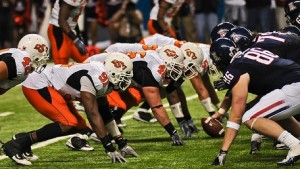Economist Allen Sanderson Answers Your Questions on Taxing College Football
 Photo: ShuttrKing|KT
Photo: ShuttrKing|KTLast week, we posted an essay by University of Chicago economist Allen R. Sanderson on why he thinks a “sin tax” should be levied against Division I college football. His basic point is that student-athletes essentially serve as unpaid labor, and since most of them never make it to the NFL (or end up out of the league after just a few years), the extra tax revenue should go toward supporting them in their effort to finish their education.
You responded quickly with a variety of comments and opinions; though not so many direct questions. So Allen has written a response that’s broadly aimed at some of the points brought up by a number of readers. Overall, it’s a good (and provocative) read that focuses on the bizarre economics of Division I college football.
Taxing College Football
By Allen Sanderson
First of all, thanks for all the great comments, suggestions and complaints. Good conversations!
In terms of Alex’s comment about “where’s the harm” (or the negative externality), I think the best way to look at it is not unlike the Antebellum South and slavery. To be sure, today’s Division I college athletes are not slaves, nor were they drafted; they volunteered, and expected to benefit more by playing football for Big State University than from their next best alternative. That said, the harm, returning to the slavery analogy, is that fans of football today are able to consume a product that is subsidized by the use of unpaid labor. If the price of football tickets rose by 50 percent, as did logo merchandise and TV broadcasts, and you didn’t want to buy in, then fine. But let’s put our money where our mouths is.
In general terms, yes, players do benefit. But that’s not the point. It’s the extent to which they benefit compared to the coaches and other athletic personnel that matters. For example, compare the average salary of NFL players to the average salary of the NFL coach. Then do the same thing for college football players. The Detroit Lions devote about half their revenue to players’ salaries, while down the road a few miles, the University of Michigan pencils in about 10 percent of its revenues for player “salaries.” In a competitive marketplace, these two costs would be much closer to each other. The difference gives you a rough approximation of the exploitation rate.
The age issue – to Michael’s comment – is an important one. I’m allowed to drop out of college, or not go at all, if I want to start a computer business in my garage, star in a Hollywood movie, or pursue whatever whim or dream I have. But the cozy relationship between the NCAA and the NFL requires that these athletes spend effectively half their useful economic lives in unpaid internships (a.k.a. athletic grants in aid) so that professional teams can do things like determine how good their knees are before drafting them. The average NFL player is only in the league for four years (actually, it’s 3.4 years, per Dubner’s conversation with NFLPA head DeMaurice Smith), which is roughly the same amount of time he spends in college before being eligible for the draft. The NFL benefits from this arrangement; the university benefits, but at some point well shy of four years, the player does not.
To Joshua Northey’s comment, it’s much harder to sue the NCAA and colleges for collusion, than it is to sue the NFL. Not impossible, just harder. And the cartel that is the NCAA caps the players’ salaries, but can’t do the same for coaches because they’d be hauled into court (and likely lose) in a New York minute. So, coaches can sell their services to the highest bidder, while the student athlete cannot.
Take this rough example: If the American Economic Association could cap all assistant professor salaries at $50,000 a year, wouldn’t it still be beneficial to pursue a career of teaching and research? Sure, just not nearly as lucrative. Why don’t the leading 50 PhD programs join together to enact such a plan? (See the Sherman Act)
By the way, I am in favor of Title IX opportunities for women, but I’m not sure why those scholarships, and for non-revenue sports in general, have to be financed on the backs of the football and men’s basketball teams. If the institution wants to field women’s teams, great. (Plus legally it will have to.) But then why should football players fund these things? Find another source. In addition, the vast majority of NCAA football and men’s basketball players are African-American; the vast majority of NCAA volleyball, baseball, swimming, lacrosse, etc. players are white, and from middle and upper-income families. At least Robin Hood took from the “millionaires and billionaires.”
Being a football or basketball player at a Division I university is a full-time job, leaving little in the way for much of a life outside the weight-room or practice field. So the “kid” is unlikely to get anything in the way of a decent education. There aren’t that many hours in the week. Plus I’m not sure why graduation rates are a good gauge of a program’s academic side. The athlete is really only at the university to play ball. Case in point, during a nationally-televised college game last weekend, the announcer referred to a player who wanted to transfer; not because another university had a better chemistry department, but because the kid thought he could start (at QB in this case) somewhere else. Let’s stop kidding ourselves: these athletes are in college because the professional leagues require a certain period of indentured servitude.

Comments